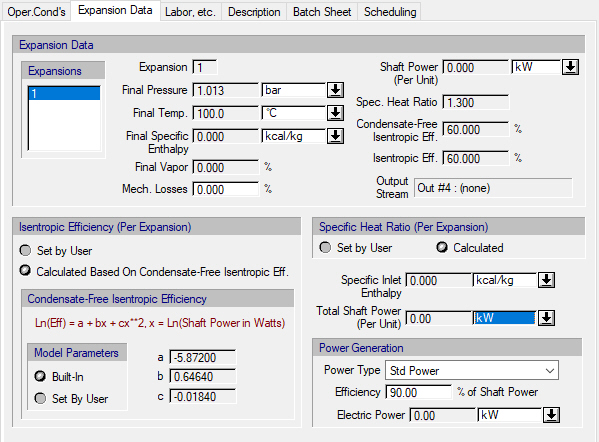

The following table shows a brief description of the variables appearing in this tab. The table also displays their default values and their generally acceptable range. Note that due to how the variables are used in the modeling equations, the range of acceptable values may be further reduced; for more details, see Power Generation in a Steam Turbine-Generator: Modeling Assumptions & Constraints.
|
Variable |
Default Value |
Range |
|
|
||
|
● Expansion |
1 |
1-4 |
|
◙ Final Pressure (atm) |
1.0 |
Positive |
|
● Final Temp. (oC) |
100.0 |
Positive |
|
● Final Specific Enthalpy (W) |
0.0 |
Positive |
|
● Final Vapor (%) |
0.0 |
Positive |
|
○ Mech. Losses (%) |
0.0 |
0-100 |
|
● Shaft Power (Per Unit) |
0.0 |
Positive |
|
◙ Specific Heat Ratio |
1.3 |
Positive |
|
● Condensate-Free Isentropic Eff. (%) |
60.0 |
0-100 |
|
◙ Isentropic Efficiency (%) |
60.0 |
0-100 |
|
● Output Stream |
<none> |
Any Name |
|
◙ a |
-5.872 |
Any Number |
|
◙ b |
0.6464 |
Any Number |
|
◙ c |
-0.0184 |
Any Number |
|
● Specific Inlet Enthalpy (W) |
0.0 |
Positive |
|
● Total Shaft Power (Per Unit) (W) |
0.0 |
Positive |
|
○ Power Type |
<Std Power> |
Any Power Type |
|
○ Power Generator Efficiency (%) |
90.0 |
0-100 |
|
● Electric Power |
0.0 |
Positive |
Symbol Key: ○ User-specified value (always input); ● Calculated value (always output); ◙ Sometimes input, sometimes output
The following list describes the available specification choices in this tab; for more details on how these are implemented, see Power Generation in a Steam Turbine-Generator: Modeling Calculations.
•Isentropic Efficiency Options...
You can either set the isentropic efficiency of each expansion directly, or calculate it based on the condensate-free isentropic efficiency.
•Condensate-Free Isentropic Efficiency Options...
If the isentropic efficiency of each expansion is calculated based on condensate-free isentropic efficiency, you can either use the built-in quadratic curve or specify custom parameters for that curve in order to calculate the condensate-free isentropic efficiency of each expansion. The built-in curve is valid for steam and for power output in the range of 100 W - 1.5 MW. If you choose the custom curve, the model checks that the following additional constraints are satisfied with respect to the values of curve parameters a, b, and c:
a) a must be <=0.
b) If c=0, then b must be <>1.
c) If c<>0, then the discriminant of the quadratic curve must be >0.
•Specific Heat Ratio Options...
These options are available only if the Analytical Isentropic Expansion Model is selected through the Oper. Conds Tab. In that case, you can either set the specific heat ratio for each expansion, or let the program calculate its value by assuming ideal gas behavior.